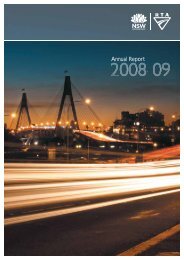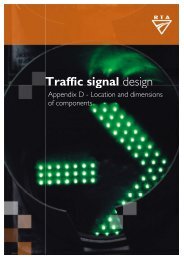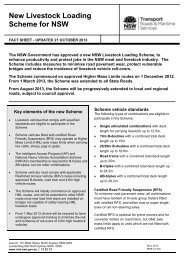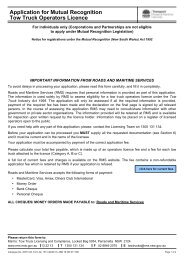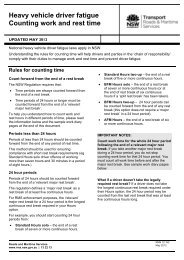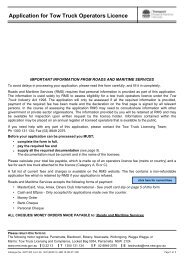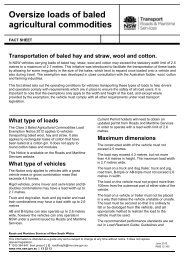Annual Report 2006 (main body) - RTA - NSW Government
Annual Report 2006 (main body) - RTA - NSW Government
Annual Report 2006 (main body) - RTA - NSW Government
Create successful ePaper yourself
Turn your PDF publications into a flip-book with our unique Google optimized e-Paper software.
A five year program to promote healthy<br />
lifestyles was implemented in the financial<br />
year as an extra dimension to the <strong>RTA</strong>’s safety<br />
culture. Stage 1 of the AlphaOne Integrated<br />
Workplace Health and Fitness Program has<br />
been implemented for 19 work groups<br />
across <strong>NSW</strong> with 400 staff from road<br />
services, motor registries, vehicle regulations<br />
and the senior executive attending health<br />
forums that link personal health and<br />
behaviours with workplace risks. More than<br />
80 per cent of participants have taken up the<br />
offer of a fitness assessment with 94 per cent<br />
stating that they intend to take action as a<br />
result of their health and fitness assessment.<br />
OHS program delivery<br />
The task of delivering OHS programs is a<br />
cooperative effort between OHS Branch,<br />
regionally based OHS facilitators and line<br />
managers and their staff. The <strong>2006</strong> Safety<br />
Summit for Road Services Managers<br />
confirmed the effectiveness of the OHS<br />
improvement action plan which included<br />
better incident management, a focus on the<br />
role of line managers and supervisors and<br />
the implementation of lead indicators for<br />
OHS. The Executive supported bedding<br />
down the improvement plan initiatives in<br />
TRAFFIC<br />
CONTROL AT<br />
WORKSITES<br />
A corporate steering committee was<br />
established in late 2005 to develop a<br />
comprehensive strategy for improving<br />
traffic control at worksites, leading to<br />
increased safety for road workers<br />
and contractors.The strategy will deliver<br />
increased awareness and importance of<br />
traffic control at <strong>RTA</strong> worksites, a traffic<br />
control specification review, increased<br />
public awareness and enhanced<br />
enforcement activities.<br />
Chris Mihellis installing containment for lead paint removal on the lower chord of the Sydney Harbour Bridge.<br />
<strong>2006</strong>–07, supported by greater awareness<br />
of OHS situations. The OHS Branch has<br />
a key role in measuring the extent of<br />
OHS management system implementation<br />
through audits and inspections.<br />
Contractor safety<br />
Working closely with its contractors, the<br />
<strong>RTA</strong> continues to seek high standards of<br />
safety. The <strong>RTA</strong> Executive OHS committee<br />
closely monitors contractor safety<br />
performance through site inspections,<br />
systems audits and a monthly review of<br />
OHS performance indicators. The <strong>RTA</strong><br />
reassessed all principal contractors’<br />
corporate OHS management systems in<br />
2005–06, developed a suite of model<br />
documents and provided internet access for<br />
contractors and local councils to the <strong>RTA</strong><br />
OHS policy framework and associated<br />
information. <strong>RTA</strong> principal contractors<br />
continue to perform below the national lost<br />
time injury frequency rate and well below<br />
that of <strong>NSW</strong>. Despite much effort two<br />
contractor deaths occurred at <strong>RTA</strong><br />
worksites in 2005–06. Each death was fully<br />
investigated by both the <strong>RTA</strong> and the<br />
contractors to identify the root cause and<br />
learn from the experience.<br />
OHS improvement in the<br />
civil construction industry<br />
Work continues between the <strong>RTA</strong> and local<br />
government to improve OHS performance<br />
in road construction and <strong>main</strong>tenance. The<br />
local councils' workshops, begun in 2004–05,<br />
have continued this year. The program<br />
includes hazard specific workshops to<br />
promote better understanding and<br />
compliance with OHS requirements on civil<br />
construction worksites.<br />
Details of injuries and prosecutions<br />
OHS incidents<br />
Working in traffic continues to be the<br />
most significant risk of serious injury to<br />
<strong>RTA</strong> employees and contractors. A risk<br />
assessment approach has been implemented<br />
that supports increased awareness of<br />
hazards and changing local conditions. EnSite<br />
risk assessments are conducted before the<br />
start of all major road projects. Similarly,<br />
<strong>main</strong>tenance crews are also conducting<br />
risk assessments prior to commencing<br />
remedial works. Standard traffic management<br />
techniques are being augmented by feedback<br />
from local knowledge incorporated in the<br />
site risk assessments.<br />
The most common cause of injuries across<br />
70 VALUE FOR MONEY



